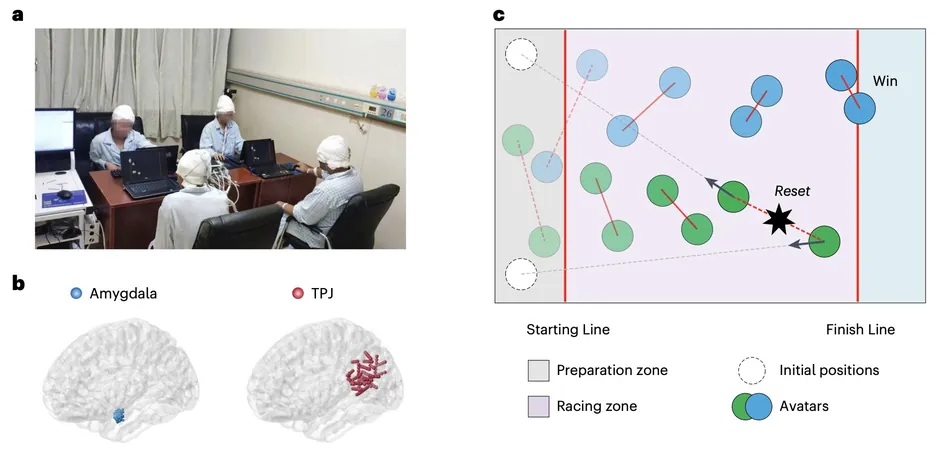
Unlocking the Secrets of Human Cooperation: A Groundbreaking Study Reveals Surprising Neural Insights
2025-01-20
Author: Wei Ling
Introduction
In an exciting development within the realm of neuroscience, a recent study conducted by a research team at Beijing Normal University has uncovered new insights into the neural mechanisms underlying human cooperation. This research not only sheds light on how we work together but also opens the door to understanding complex social interactions that influence every aspect of our daily lives.
The Importance of Collaboration
Collaboration is fundamental to achieving shared goals, yet the intricate relationship between cooperative behavior and its neural basis has remained largely unexplored. Led by Dr. Yina Ma, the team conducted innovative experiments that combined behavioral tasks with intracranial electroencephalography (iEEG) to delve deep into the neural underpinnings of teamwork and joint decision-making. Their findings, published in *Nature Neuroscience,* highlight distinct neurocognitive profiles associated with different stages of cooperation.
Research Focus and Methodology
Co-first author Jiaxin Wang stated, "Our lab has been committed to deciphering how human brains communicate in social contexts, including collective decision-making and intergroup dynamics." The researchers specifically focused on a fascinating phenomenon known as inter-brain neural synchronization, where brain activities of interacting individuals become correlated. However, traditional methods of studying cooperative behaviors have often relied on isolated decision tasks, which fail to reflect the dynamic nature of real-life interactions.
Innovative Experiment Design
To advance their research, the team designed a virtual interactive cooperation game modeled after a "three-legged" race. In this innovative experiment, pairs of participants had to maneuver their avatars towards each other and establish a connection to succeed—an approach that effectively simulated natural collaborative environments. This was made possible by recruiting epilepsy patients who already had electrodes implanted in their brains for medical purposes.
Findings of the Study
As these patients participated in the cooperation task, the team simultaneously recorded neural activity from crucial brain areas, including the amygdala and the temporoparietal junction (TPJ). Remarkably, the analysis revealed two critical states of cooperation: initiation and maintenance. Each distinct state exhibited unique social motives and neural dynamics, providing unprecedented insights into how we cooperate.
Neural Synchronization and Cooperation
The researchers discovered a remarkable correlation: the level of neural synchronization among different brain regions directly impacted the efficacy of cooperation. Enhanced synchrony in brain activity was indicative of well-coordinated behavior, whereas diminished synchrony led to fragmented efforts—a revelation that has profound implications for understanding social dynamics.
Future Directions of Research
As they look to the future, Wang expressed hopes of expanding their findings beyond the current study. They aim to explore the neural processes involved in cooperation across diverse scenarios, including social dilemmas, and investigate additional brain areas related to reward processing and motor functions. "By leveraging iEEG and innovative experimental designs, I believe we can deepen our understanding of the neural foundations of cooperation across various contexts and populations," Wang added.
Conclusion
This groundbreaking study has the potential to transform how we understand not just cooperation, but also the foundational elements of human social interaction. As we continue to unveil the mysteries of our neural networks, the implications for enhancing collaboration in personal, educational, and professional settings could be monumental. Stay tuned—a new frontier in the study of human connection is unfolding, and you won’t want to miss what’s next!


 Brasil (PT)
Brasil (PT)
 Canada (EN)
Canada (EN)
 Chile (ES)
Chile (ES)
 Česko (CS)
Česko (CS)
 대한민국 (KO)
대한민국 (KO)
 España (ES)
España (ES)
 France (FR)
France (FR)
 Hong Kong (EN)
Hong Kong (EN)
 Italia (IT)
Italia (IT)
 日本 (JA)
日本 (JA)
 Magyarország (HU)
Magyarország (HU)
 Norge (NO)
Norge (NO)
 Polska (PL)
Polska (PL)
 Schweiz (DE)
Schweiz (DE)
 Singapore (EN)
Singapore (EN)
 Sverige (SV)
Sverige (SV)
 Suomi (FI)
Suomi (FI)
 Türkiye (TR)
Türkiye (TR)
 الإمارات العربية المتحدة (AR)
الإمارات العربية المتحدة (AR)